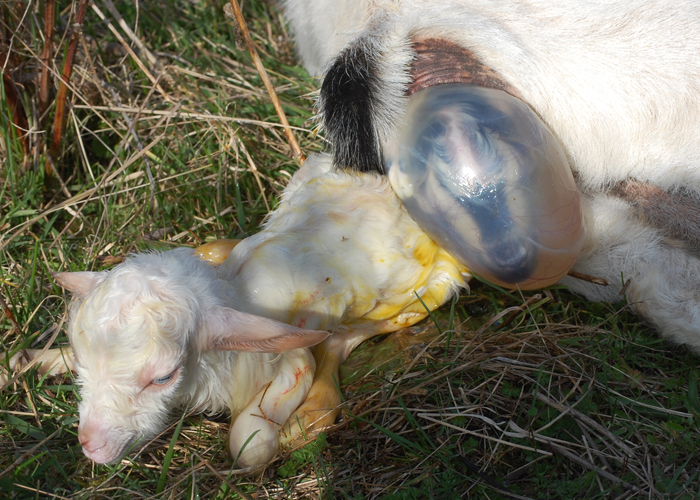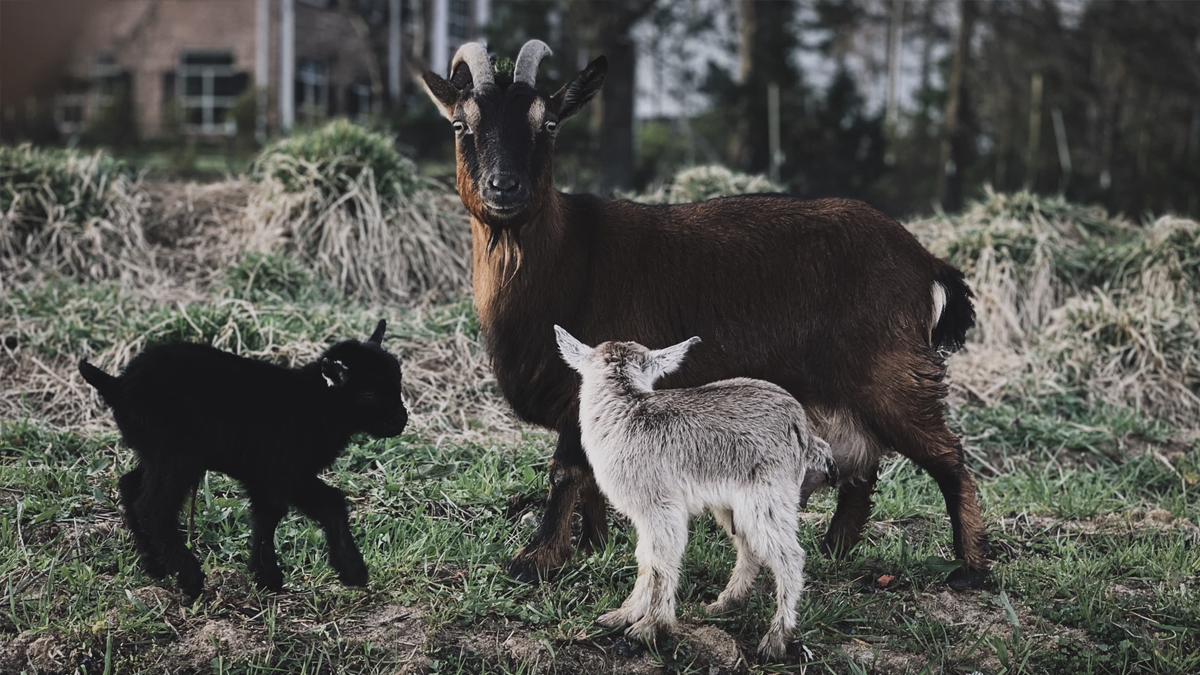on
Calving, lambing, kidding, etc is the most exciting time of the year. It is also the most gut-wrenching, sleepless season of the year as well. Especially when you are new to it all, you will second guess yourself, your knowledge and your abilities. For those that are new to this, find yourself a local mentor that is willing to come over and guide you through it the first few times.
Birth in livestock is a natural process and normally does not need any human interference. But sometimes there can be birth problems where the dam needs assistance with delivery. Or in cases where an animal is giving birth to multiples, she may need help getting their airways cleared. For example, just a few days ago we had a doe that kidded with quads in 12 minutes. She didn’t need any help delivering them, but without assistance to clear their airways, we would have likely lost one or more kids.
Gestation ranges
Pregnancy in cattle lasts on average 280 days. It can be one week less or up to two and a half weeks more. If the cow has twins she will normally give birth before the 280 days are over.
In goat and sheep pregnancy lasts 144 – 155 days, for smaller breeds of goats like Nigerian Dwarf dairy goats the normal range is 142-152 days. In pigs 110 – 118 days, in horses it lasts 336 days, in donkeys 365 days and in camels 330 – 410 days.
The shorter the gestation range for an animal the more likely that even a day or two early can result in a preemie with under developed lungs that will likely never thrive if it manages to live.
Signs of approaching birth
- One to two weeks before birth the udder swells up, there is an increasing soft swelling of the skin (edema) on the udder and in front of the udder, thick colostrum appears in the teats.
- A few hours before birth the pregnant animal becomes restless, the animal stops to feed or drink, it may lie down and stand up again frequently, there may be the first discharge of mucous from the vagina. (Note: some goats will eat all the way through delivery.)
- The preparation stage takes normally 2 to 6 hours but can vary between 1 and 24 hours (occasionally up to 72 hours in heifers!)
- The ligaments at both sides of the base of the tail sink in.
- The vulva swells up to several times its’ normal size and becomes flabby
- A lot of thick white mucous is discharged from the vulva.
Make sure the animal has a clean and quiet place where she can give birth. Don’t put animals into stress because of removing it from familiar surroundings: when possible leave it in the herd when there is space to find a quiet place.
Prepare yourself: Your fingernails need to be very short and smooth, and your hands clean. If you have long hair, tie it back out of the way. Have a bucket of warm water and soap handy to wash up if you have to “go in”, and lubricant that is warmed. Have a calf, sheep or goat snare – or appropriately sized rope/cord that has been boiled to sanitize it. Clean towels for clearing noses are also handy to have.

Monitoring birth progress
- Labor starts, normally while the animal is lying down, the contractions of the uterus occur about every 15 minutes
– Labour in cattle normally takes around 3 to 4 hours, but can take much longer with first-calving heifers; After about 3 to 4 hours of labor the waterbag (= the membrane sack which contains the calf) becomes visible in the vulva
– Labour in sheep/goat is much shorter (about 30 minutes) - It is important to observe when the waterbag bursts (or ‘the water breaks’), from this moment on the delivery of the calf/lamb/kid begins, the uterus contractions now occur every 2 minutes
- Labour comes in repeated intervals until the second membrane bursts and the two feet of the calf/lamb/kid appear
- In most cases calf/lamb/kid are born with the head between the two front feet coming first, but they can also be born with hind-legs and tail coming first
- The normal position of the calf/lamb/kid inside the mother is with the back facing up and the belly facing down (if it is not so see below under difficult birth)
- Now observe until the calf/lamb/kid has been fully delivered, sometimes the mother takes a short break before expelling the calf completely, expulsion of the calf normally takes between 30 minutes (adult cows) and three hours (first-calving heifers)
– For goat/sheep the time is much shorter usually just a few minutes, and since both goats and sheep tend to have at least twins, be prepared to assist with additional births. Nigerian Dwarf goats most commonly have twins and triplets, but quads are not unusual and quints and septuplets also occur. Occasionally does have had additional kids after they have delivered the placenta, but generally speaking, once you see the placenta birthing is finished.

Care after birth
- Make sure the calf/lamb/kid starts to breathe immediately after birth.
- If the newborn is slow in starting to breathe, you can clear mucous from its nose, tickle the nose of it with a straw and vigorously rub the chest of the newborn to stimulate it.
- It is good to show the young animal to the mother by placing it near her head and allow her to lick it
- The navel of the calf/lamb/kid should be disinfected by dipping it in iodine
- When the calf/ lamb/ kid starts to stand up you should assist it to suckle, this helps with expulsion of the afterbirth
- The first milk produced by the dam is very thick and yellow and is called colostrum; this colostrum is like a vaccination, it transfers immunity from the mother to the young which protects the calf/lamb/kid during the first 3 to 6months
- Colostrum is very nutritious, it contains much more protein, vitamins and minerals than normal milk and also activates movement of the intestine and helps with passing of the first faeces. The calf/lamb/kid gets a good start in life when fed enough colostrum
- The calf/lamb/kid should suckle for the first time not later than 3 hours after birth. But preferably within the first hour.
– The newborns need to receive a minimum 10% of their birth weight in colostrum if they are needing a bottle.
– If the calf/lamb/kid receives colostrum too late, the antibodies in it cannot pass the intestinal wall anymore and the newborn’s immunity is very weak and it may die easily. - In cattle/goats/sheep expulsion of the afterbirth is normally complete 2 hours after birth, but it can sometimes take up to 8 hours. Whenever possible try to observe the expulsion, especially after a difficult birth so you know there was nothing retained. The dam may occasionally want to eat the placenta, this should be allowed, but watch for potential choking issues.
- To avoid the onset of milk fever in high milk-yielding animals give a calcium supplement or drench.
Things NOT to do during birth
Many people interfere with birth too early or when it is unnecessary causing more harm than good. Allow the cow, sheep or goat sufficient time and quietness to deliver her calf, lamb or kid.
- Do not chase or cause stress to the animal before and during birth, making the dam nervous can disrupt labor and delay birth by many hours
- Do not interfere before the water has broken; as long as the water has not broken the calf/lamb/kid will stay alive inside the mother for a long time (up to 12 hours). If there seems to be no progress at all after the waterbag has become visible (= the waterbag does not move through the vulva and the water does not break) you must wait at least one hour before checking the position of the calf.
- If birth progresses normally do not attempt to pull. Unnecessary pulling can easily cause injury to the newborn and the mother
- When the animal relaxes, do not try to pull out the calf/lamb/kid by force, labor happens at intervals and you are not supposed to pull when the mother rests; hard pulling on the calf/lamb/kid can easily cause prolapse of the uterus which frequently causes the death of both, the mother and the young
- If the afterbirth does not come out normally do not try to put your hands in and don’t try to pull it out, you will cause damage and bleeding to the uterus which could be fatal.
- When you see milk drops on the teats, do not start to milk the cow/goat/sheep before birth, this will make her colostrum useless for her young.
When to assist with a difficult birth
- After the water has broken, the birth must progress. If the mother has been pushing hard for 2-4 hours but there is no visible progress and she becomes tired you must check the position of the calf/lamb/kid.
- If the position of the calf/lamb/kid is normal but the mother is tired, you may assist by pulling gently on the two legs of the calf/lamb/kid, but only pull when the mother is pushing herself; also make sure you have washed the skin around the vulva and your hands thoroughly with soap before assisting.
- Never pull on the calf/lamb/kid unless you can clearly locate three things:
– Two legs with the nose/head pointing upwards towards the mother’s tail
or
– Two legs with tail pointing upwards towards the mother’s tail - If the birth takes long the vulva surface becomes too dry and it is good to apply some foam from bar-soap or from liquid soap onto the surface
- If you are not sure about how to check the position call an experienced person or a veterinarian. This is where having a local mentor comes in very handy.
- If the afterbirth is retained wait for 12 hours then call a veterinarian to treat the animal; the vet will give the cow an antibiotic until the afterbirth has sloughed off; if a retained afterbirth is not treated it can cause a severe infection of the mother and lead to death or infertility

Get access to premium content and more!





